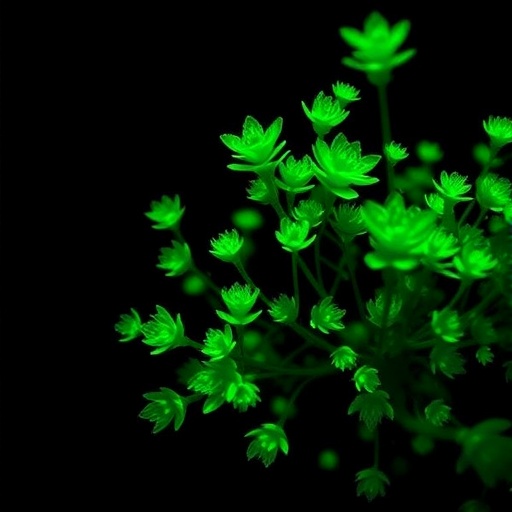In an intriguing intersection of biotechnology and nanotechnology, recent research has unveiled groundbreaking techniques aimed at enhancing photosynthesis in microorganisms through novel photoluminescent materials. The study, conducted by a team of scientists led by Zahri F., along with colleagues Salehi-Lisar S.Y. and Razeghi J., investigates the potential for carbon dots derived from Haematococcus pluvialis algae to optimize photosynthetic efficiency and increase bioproduct yields. The implications of this research could be significant, not just for our understanding of plant biology but also for applied fields such as biofuels, pharmaceuticals, and sustainable agriculture.
The innovative study begins by addressing the critical need for increased efficiency in photosynthesis, particularly in the face of global climate change and the increasing demand for renewable energy sources. Photosynthesis, the natural process by which plants convert sunlight into chemical energy, is fundamental to life on Earth. However, the efficiency of this process can be significantly improved through the introduction of engineered nanomaterials. Carbon dots, nanoscale materials that exhibit strong photoluminescence, have garnered attention due to their unique optical properties and biocompatibility, making them ideal candidates for agricultural applications.
The research explores how carbon dots can enhance the photosynthetic efficiency of Haematococcus pluvialis, a microalga known for its high production of astaxanthin, a powerful antioxidant. By optimizing the photoluminescent properties of carbon dots, the researchers aimed to discover how these materials could interact with the algal cells to facilitate more effective light capture and energy transfer. This novel approach diverges from traditional methods, which often rely solely on genetic modification or agronomic practices to enhance plant performance.
In this study, the team utilized a comprehensive suite of methods to synthesize carbon dots that fluoresce effectively under specific light wavelengths. After adjusting parameters such as size and surface functional groups, the researchers observed a marked increase in the photoluminescence properties of the carbon dots. Importantly, they found that these modifications allowed the carbon dots to absorb light energy more effectively, which subsequently influenced the photosynthetic pathways within the Haematococcus pluvialis cells.
Through controlled experiments, the researchers discovered that the integration of carbon dots into the cultivation medium of Haematococcus pluvialis resulted in significantly enhanced algal growth rates. This increase in biomass can directly correlate with higher yields of bioactive compounds, thereby suggesting a pathway through which these materials could enhance the economic viability of microalgal cultivation. The implications of this research extend beyond mere biomass increase; they also open avenues for improving the extraction processes of valuable compounds from microalgae.
Another fascinating aspect of the research lies in the examination of the biochemical pathways influenced by the presence of carbon dots. The study presents compelling evidence that these nanomaterials interact with the algal cells in such a way that they not only enhance growth but may also affect the synthesis of essential metabolites. This discovery is particularly important given the rising global interest in natural antioxidants, which have widespread applications from food preservation to medical uses.
Moreover, the researchers highlighted the role of photoluminescence in modulating cellular stress responses in aquatic organisms. The ability of carbon dots to produce non-photochemical quenching could serve as a protective mechanism for Haematococcus pluvialis against excessive light levels, which typically induce oxidative stress. By providing an enhanced light-harvesting mechanism, the carbon dots may contribute to a more robust survival strategy for the algae under varying environmental conditions.
This study represents a significant breakthrough in the application of nanotechnology within the realm of agriculture and biotechnology. By harnessing the properties of carbon dots, the research emphasizes the potential for creating more resilient strains of microalgae and optimizing bioproduction processes. The successful cultivation of Haematococcus pluvialis in conjunction with carbon dots could lead to more efficient production systems, allowing for increased economic returns while simultaneously fostering sustainable practices.
Furthermore, the implications of this research stretch into larger discussions surrounding food security and sustainable energy solutions. As the global population continues to expand, innovative approaches that enhance agricultural productivity will be crucial. The ability to leverage nanotechnology for improved photosynthetic efficiency could play a crucial role in developing more sustainable agricultural systems that use fewer resources while yielding higher outputs.
As the study concludes, the authors suggest that future research should focus on the long-term effects of carbon dot application in different environmental scenarios to assess durability and efficacy in real-world agricultural settings. The collaboration between biologists, chemists, and materials scientists will be fundamental in scaling these findings for broader applications. Furthermore, understanding the regulatory implications of using nanomaterials in agriculture will also be vital to ensure safety and consistency in the production of bioactive compounds.
In conclusion, the innovative integration of photoluminescent carbon dots with Haematococcus pluvialis represents a promising frontier in both agricultural biotechnology and nanotechnology. The potential to not only boost photosynthesis but also enhance the quality and yield of bioactive compounds could revolutionize approaches to sustainable agriculture and renewable energy sources. With ongoing research and technological advancements in this field, we may witness a new era of efficiency and sustainability in bio-production processes.
In summary, the work of Zahri and colleagues opens up exciting possibilities for utilizing nanotechnology in a way that harmonizes with nature’s own processes, merging the line between biotechnology and the advancements of nanomaterials. The time to harness such technologies could define the next steps toward a greener and more sustainable future in global food and energy production.
Subject of Research: Utilizing Carbon Dots to Enhance Photosynthesis in Haematococcus pluvialis Algae.
Article Title: Optimizing photoluminescence in carbon dots-Haematococcus pluvialis algae to increase photosynthesis and bioactive compounds.
Article References:
Zahri, F., Salehi-Lisar, S.Y., Razeghi, J. et al. Optimizing photoluminescence in carbon dots-Haematococcus pluvialis algae to increase photosynthesis and bioactive compounds.
Environ Sci Pollut Res (2025). https://doi.org/10.1007/s11356-025-36911-5
Image Credits: AI Generated
DOI:
Keywords: Carbon dots, Haematococcus pluvialis, Photoluminescence, Photosynthesis, Bioactive compounds, Nanotechnology, Sustainable agriculture.




